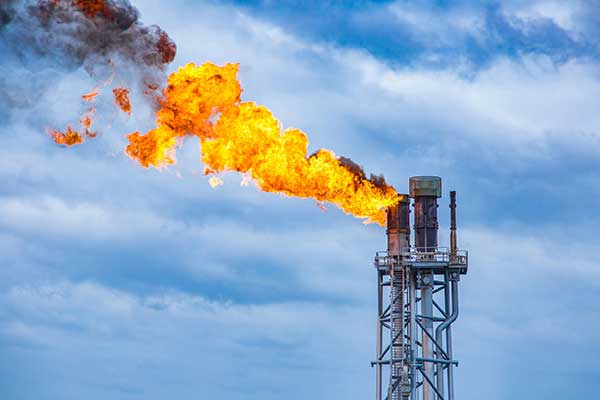This article discusses the meaning of natural gas, the history, benefits, uses and also the challenges and concerns of using natural gas.
WHAT IS NATURAL GAS?
It is a mixture of gases which are rich in hydrocarbons. All these gases (methane, nitrogen, carbon dioxide etc.) are naturally found in atmosphere. its reserves are deep inside the earth near other solid & liquid hydrocarbons beds like coal and crude oil.
Natural gas is a hydrocarbon mixture consisting primarily of saturated light paraffins such as methane and ethane, both of which are gaseous under atmospheric conditions.
Natural gas is a fossil fuel and non-renewable resource that is formed when layers of organic matter (primarily marine microorganisms) decompose under anaerobic conditions and are subjected to intense heat and pressure underground over millions of years. The energy that the decayed organisms originally obtained from the sun via photosynthesis is stored as chemical energy within the molecules of methane and other hydrocarbons.
It can be burned for heating, cooking, and electricity generation. It is also used as a chemical feedstock in the manufacture of plastics and other commercially important organic chemicals and less commonly used as a fuel for vehicles.
The extraction and consumption of natural gas is a major and growing contributor to climate change. Both the gas itself (specifically methane) and carbon dioxide, which is released when natural gas is burned, are greenhouse gases. When burned for heat or electricity, natural gas emits fewer toxic air pollutants, less carbon dioxide, and almost no particulate matter compared to other fossil and biomass fuels. However, gas venting and unintended fugitive emissions throughout the supply chain can result in natural gas having a similar carbon footprint to other fossil fuels overall.
READ: NATURAL GAS PROCESSING PLANT
It can be found in underground geological formations, often alongside other fossil fuels like coal and oil (petroleum). Most natural gas has been created through either biogenic or thermogenic processes. Biogenic gas is formed when methanogenic organisms in marshes, bogs, landfills, and shallow sediments anaerobically decompose but are not subjected to high temperatures and pressures. Thermogenic gas takes a much longer period of time to form and is created when organic matter is heated and compressed deep underground.
During petroleum production, natural gas is sometimes flared rather than being collected and used. Before it can be burned as a fuel or used in manufacturing processes, it almost always has to be processed to remove impurities such as water. The byproducts of this processing include ethane, propane, butanes, pentanes, and higher molecular weight hydrocarbons. Hydrogen sulfide (which may be converted into pure sulfur), carbon dioxide, water vapor, and sometimes helium and nitrogen must also be removed.
Natural gas is sometimes informally referred to simply as “gas”, especially when it is being compared to other energy sources, such as oil, coal or renewables. However, it is not to be confused with gasoline, which is also shortened in colloquial usage to “gas”, especially in North America.
HISTORY
Natural gas can come out of the ground and cause a long-burning fire. In ancient Greece, the gas flames at Mount Chimaera contributed to the legend of the fire-breathing creature Chimera. In ancient China, gas resulting from the drilling for brines was first used by about 400 BC. The Chinese transported gas seeping from the ground in crude pipelines of bamboo to where it was used to boil salt water to extract the salt in the Ziliujing District of Sichuan.
It was not widely used before the development of long-distance pipelines in the early twentieth century. Before that, most use was near to the source of the well, and the predominant gas for fuel and lighting during the industrial revolution was manufactured coal gas.
The history of natural gas in the United States begins with localized use. In the seventeenth century, French missionaries witnessed the American Indians setting fire to natural gas seeps around Lake Erie, and scattered observations of these seeps were made by European-descended settlers throughout the eastern seaboard through the 1700s. In 1821, William Hart dug the first commercial natural gas well in the United States at Fredonia, New York, United States, which led in 1858 to the formation of the Fredonia Gas Light Company. Further such ventures followed near wells in other states, until technological innovations allowed the growth of major long-distance pipelines from the 1920s onward.
BENEFITS
- Cleaner energy source: It produces fewer greenhouse gas emissions and pollutants compared to coal and oil, making it a more environmentally friendly option.
- Abundant supply: reserves are widespread globally, ensuring a stable and secure energy supply.
- Flexible energy source: it can be used for power generation, industrial processes, transportation, and residential heating and cooking.
- Economic benefits: it can create jobs, stimulate local economies, and generate revenue for governments.
USES
- Power generation: it is used to fuel power plants, producing electricity for homes, industries, and businesses.
- Industrial applications: it is used as a fuel and feedstock for various industrial processes, such as manufacturing chemicals, fertilizers, and pharmaceuticals.
- Transportation: Compressed natural gas (CNG) and liquefied natural gas (LNG) are used as alternative fuels for vehicles, reducing emissions and operating costs.
- Residential and commercial uses: it is used for heating, cooking, and powering appliances in homes and businesses.
CHALLENGES AND CONCERNS
- Environmental impact: While natural gas is a cleaner-burning fuel, its extraction, processing, and transportation can still harm the environment and local communities.
- Climate change: it is a fossil fuel, and its combustion contributes to greenhouse gas emissions, accelerating climate change.
- Infrastructure and transportation risks: the infrastructure and transportation can be vulnerable to accidents, leaks, and cyber threats.
- Market volatility: the prices can fluctuate significantly, affecting energy costs and economic stability.

